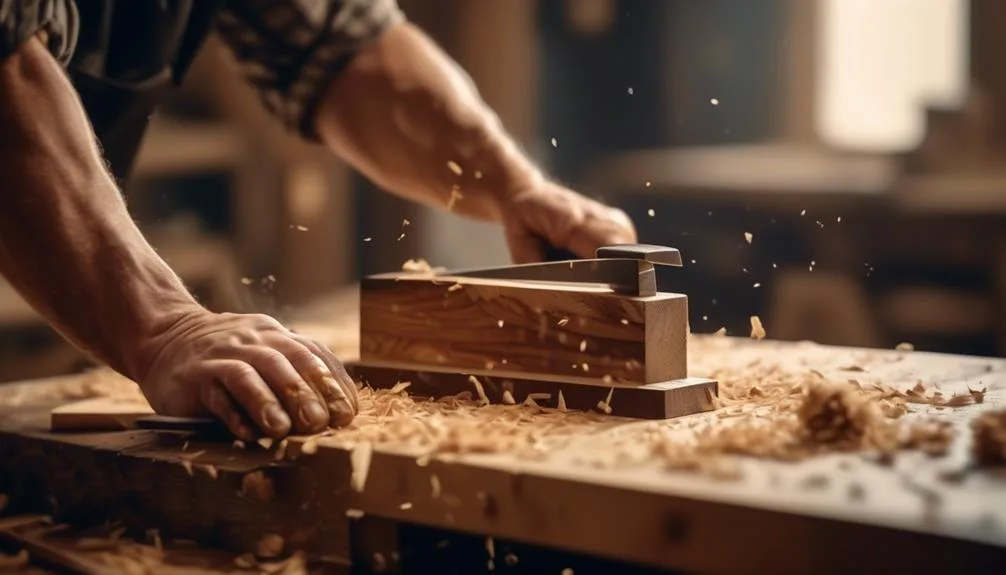Hickory wood is prized for its strength and attractive grain patterns, making it a popular choice for carpentry. Whether you're working on furniture or flooring, hickory adds a timeless touch to any space.
This article will explore the different types of hickory wood, how to prepare it for carpentry, the best tools and techniques for working with it, and tips for finishing and maintaining your projects.
Whether you're a seasoned carpenter or a DIY enthusiast, there's always more to learn about hickory wood.
Types of Hickory Wood for Carpentry
What makes hickory wood an excellent choice for carpentry projects?
Hickory wood is known for its exceptional strength, durability, and shock resistance, making it a top choice for various carpentry applications.
Its prominent grain patterns and natural brown hues also add a beautiful, rustic charm to finished projects.
When selecting hickory lumber, it's important to look for straight, clear boards with minimal knots and defects.
Hickory wood characteristics include a high density and stiffness, making it suitable for heavy-duty furniture, tool handles, and flooring.
Its tough nature also makes it a popular choice for items that undergo frequent wear and tear.
Whether you're crafting a sturdy dining table or durable cabinets, hickory wood is a reliable option that brings both strength and aesthetic appeal to your carpentry projects.
Preparing Hickory Wood for Carpentry
To prepare hickory wood for carpentry, carefully inspect the lumber for straight, clear boards with minimal knots and defects, ensuring the best quality for your woodworking projects.
Once you've selected the right pieces, it's important to consider the drying process. Hickory wood has a dense and tight grain, which means it can take longer to dry compared to other woods. To prevent warping or splitting, stack the lumber with spacers to allow air circulation and let it dry slowly in a well-ventilated area.
Understanding hickory's wood grain characteristics is also crucial. Its prominent grain pattern and high density make it durable but challenging to work with.
When preparing hickory wood, keep in mind its unique properties to ensure the best results for your carpentry projects.
Tools and Techniques for Working With Hickory Wood
When working with hickory wood, carefully select sharp cutting tools to handle its dense and tough grain effectively. Hickory is a robust wood that requires specific tools and techniques for successful woodworking. Here are some essential tools and techniques for working with hickory:
| Tools | Techniques | Maintenance |
|---|---|---|
| Sharp chisels | Proper grain orientation | Regular sharpening |
| High-quality saws | Controlled cutting | Rust prevention |
| Durable sandpaper | Precise measuring | Blade and bit replacements |
Using sharp chisels and high-quality saws will help you navigate hickory's dense grain, while durable sandpaper ensures a smooth finish. Employing proper woodworking techniques and regular maintenance of your tools will result in successful hickory woodworking projects.
Finishing and Maintaining Hickory Wood Projects
Finishing and maintaining hickory wood projects requires careful attention to preserving the wood's natural beauty and durability through proper sealing and periodic upkeep.
When it comes to finishing techniques, hickory wood responds well to a range of sealants, including oils, varnishes, and lacquers. Prior to applying a finish, sand the wood thoroughly to achieve a smooth surface, then wipe it clean to remove any dust.
For a natural look, consider using a clear sealant to enhance the wood's grain and color.
To maintain hickory wood projects, regular dusting and occasional polishing can help retain their luster. Additionally, it's important to monitor the wood for any signs of wear or damage, addressing them promptly to ensure the longevity of your hickory wood creations.
Tips for Maximizing the Benefits of Hickory Wood
Maximizing the benefits of hickory wood involves understanding the best practices for preserving its natural beauty and durability, ensuring your projects stand the test of time. By following these tips, you can enhance the natural beauty and maximize durability of hickory wood in your carpentry projects.
| Tips for Maximizing Benefits of Hickory Wood | Description | Benefits |
|---|---|---|
| Choose high-quality hickory wood | Select dense, straight-grained wood without knots for increased durability and strength | Ensures longevity and resistance to wear and tear |
| Apply protective finish | Use clear varnish or lacquer to enhance the wood's natural beauty while providing a protective layer | Preserves the wood's appearance and prevents damage |
| Proper storage | Store hickory wood in a cool, dry place to prevent warping or cracking | Maintains the integrity of the wood over time |
Conclusion
Harness the strength and unique grain patterns of hickory wood to create enduring and striking carpentry pieces for your home or business.
From preparation to finishing, unleash the full potential of this durable and beautiful wood.
Embrace the art of carpentry with hickory and craft pieces that stand the test of time.
Mark Hoffman is a dedicated arborist and tree care specialist with over a decade of experience. His love for trees began when he visited Yosemite National Park as a teenager and was awestruck by the giant sequoias. Mark pursued his passion by studying forestry at Michigan Technological University, where he earned a Bachelor of Science degree.
Since then, he has worked tirelessly in the field of arboriculture, helping to preserve and protect trees in his community. His expertise and dedication have made him a respected leader in the industry and a valuable resource for anyone seeking advice on tree care.
